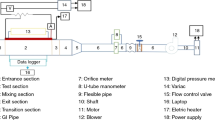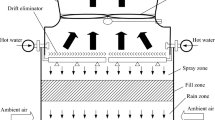Abstract
A slightly modified version of a previously published model calculating transient heat transfer under the ice of an indoor ice rink is used to evaluate the performance of two cooling fluids, a brine with 20 % calcium chloride (base case) and a calcium chloride ice slurry. Simulations are conducted for a typical meteorological year for Montreal, Canada and take into account heat entering the ice from above as well as surfacing operations and electrical underground heating used to avoid freezing which can damage the concrete slab. The results show that, for the same flow rate (28.5 l/s) and inlet temperature (−9 °C) of the cooling fluid, the ice slurry generates better ice quality (ice surface temperature is more uniform spacewise and less variable with time) but requires more pumping power. Parametric results obtained by decreasing the flow rate or by increasing the inlet temperature of the ice slurry indicate that it is possible to choose either of these operating parameters so that the resulting ice quality is better and the pumping power is lower than for the base case.












Similar content being viewed by others
Abbreviations
- C :
-
Hydraulic resistance coefficient
- c p :
-
Specific heat, in kilojoules per kilogram Kelvin
- D :
-
Diameter, in meters
- f :
-
Friction factor
- h :
-
Specific enthalpy, in kilojoules per kilogram
- L :
-
Length, in meters
- M :
-
Mass, in kilograms
- N p :
-
Number of passes
- N t :
-
Number of tubes
- \( \overset{\cdot }{m} \) :
-
Mass flow rate, in kilograms per second
- P :
-
Pumping power, in Watts
- ΔP :
-
Pressure, in kilopascal
- Q :
-
Heat transfer rate, in kilowatts
- R :
-
Thermal resistance, in Kelvin per kilowatts
- Re :
-
Reynolds number
- T :
-
Temperature, in degree Celsius
- t :
-
Time, in seconds
- V :
-
Velocity, in meters per second
- x :
-
Mass concentration, in kilograms per kilogram
- ρ :
-
Density, in kilograms per cubic meter
- ϕ :
-
Volumetric ice concentration, in cubic meters per cubic meter
- C:
-
Concrete
- cf:
-
Cooling fluid
- gr:
-
Ground
- H:
-
Electrical heater
- in:
-
Inlet of a zone
- ice:
-
Ice surface
- ins:
-
Insulation
- out:
-
Outlet of a zone
- s:
-
Solid particle
References
ASHRAE. (2005). Handbook: fundamentals (SIth ed.). Atlanta: American Society of Heating, Refrigeration, and Air-Conditioning.
Ayel, V., Lottin, O., & Peerhossaini, H. (2003). Rheology, flow behavior and heat transfer of ice slurries: a review of the state of the art. International Journal of Refrigeration, 26, 95–107.
Bellache, O., Ouzzane, M., & Galanis, N. (2005). Coupled conduction, convection, radiation heat transfer with simultaneous mass transfer in ice rinks. Numerical Heat Transfer Part A, 48, 219–238.
Bellas, I., & Tassou, S. A. (2005). Present and future applications of ice slurries. International Journal of Refrigeration, 28, 115–121.
Daoud, A., Galanis, N., & Bellache, O. (2008). Calculation of refrigeration loads by convection, radiation and condensation in ice rinks using a transient 3D zonal model. Applied Thermal Engineering, 28, 1782–1790.
El Abbassi, I., Castaing-Lasvignottes, J., Bédécarrats, J.-P., Dumas, J.-P., & Mimet, A. (2010). Energetic performances of a refrigerating loop using ice slurry. Applied Thermal Engineering, 30, 962–969.
EnergyPlus. http://www.eere.energy.gov/buildings/energyplus/.
Grozdek, M., Khodabandeh, R., & Lundqvist, P. (2009). Experimental investigation of ice slurry flow pressure drop in horizontal tubes. Experimental Thermal and Fluid Science, 33, 357–370.
Kakaç, S., & Liu, H. (2002). Heat exchangers: selection, rating, and thermal design (2nd ed.). Boca Raton: CRC Press.
Kauffeld, M., Kawaji, M., & Egolf, P. W. (2005). Handbook on ice slurries. Paris: International Institute of Refrigeration.
Kumano, H., Hirata, T., Shouji, R., & Shirakawa, M. (2010). Experimental study on heat transfer characteristics of ice slurry. International Journal of Refrigeration, 33, 1540–1549.
Monteiro, A. C. S., & Bansal, P. K. (2010). Pressure drop characteristics and rheological modeling of ice slurry flow in pipes. International Journal of Refrigeration, 33, 1523–1532.
Moran, M. J., et al. (2003). Introduction to thermal systems engineering: thermodynamics, fluid mechanics, and heat transfer. New York: Wiley. 562 pp.
Ouzzane, M., Zmeureanu, R., Scott, J., Sunyé, R., Giguere, D., & Bellache, O. (2006). Cooling load and environmental measurements in a Canadian indoor ice rink. ASHRAE Transactions, 112, 538–545.
Renaud-Boivin, S., Poirier, M., & Galanis, N. (2012). Experimental study of hydraulic and thermal behavior of an ice slurry in a shell and tube heat exchanger. Experimental Thermal and Fluid Science, 37, 130–141.
Seghouani, L., Daoud, A., & Galanis, N. (2009). Prediction of yearly energy requirements of indoor ice rinks. Energy Build, 41, 500–511.
White, F. M. (2003). Fluid mechanics (5th ed.). Boston: McGraw-Hill. 866 p.
Acknowledgments
The authors acknowledge the financial support of the Natural Sciences & Engineering Research Council (NSERC) of Canada.
Author information
Authors and Affiliations
Corresponding author
Appendix
Appendix
The coefficients in Eq. 5 are given by the following expressions:
Equivalent thermal capacities within Eqs. 8 to 13 are given by
Rights and permissions
About this article
Cite this article
Renaud-Boivin, S., Galanis, N. Performance of ice slurry as cooling fluid for an indoor ice rink. Energy Efficiency 7, 677–695 (2014). https://doi.org/10.1007/s12053-013-9247-1
Received:
Accepted:
Published:
Issue Date:
DOI: https://doi.org/10.1007/s12053-013-9247-1




